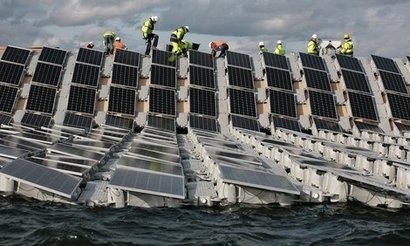
Construction of the 6.3 Megawatt peak (MWp) array began earlier this year and it now provides a source of clean energy to water utilities company, Thames Water, on the Queen Elizabeth II reservoir west of London. The project has become the first floating solar project to secure European bank financing. Thames Water will buy all energy generated by the project as part of a Power Purchase Agreement (PPA) with Lightsource.
Throughout the early stages of project planning prior to construction, OST Energy acted as technical advisor to lender RBS, providing a range of due diligence services crucial to the final investment decision.
As floating solar moves from concept to large-scale development, the involvement of a major European bank in the financing of the project is a significant milestone for the industry and a recognition of the considerable commercial advantages afforded by the technology.
High-energy users such as Thames Water, in particular, are set to benefit from the rollout of floating solar on existing water storage facilities to directly support nearby industrial applications, meet sustainability targets and reduce on-site energy costs.
However, the commercialisation of any new technology carries additional financial risk for investors, and a thorough assessment of all technical, regulatory and financial considerations involved in the construction and long-term operation of a large-scale site is an essential step ahead of investment.
Backed by RBS, solar experts Lightsource managed the technically demanding Queen Elizabeth II project, which saw the installation of more than 23,000 PV panels mounted on 61,720 individual floats, and the company will continue to operate and maintain the site for the lifetime of the project.
In order to minimise associated risks, OST Energy was engaged early in the project lifecycle to carry out an in-depth assessment of long-term energy yields, technology choices and EPC and O&M contracts, alongside a review of technical inputs to the financial model and planning and grid connection arrangements.
In doing so, OST’s specialist team of technical and engineering advisors was able to demonstrate the long-term commercial viability of the project ahead of the multi-million pound investment.
“Floating solar is a really exciting new technology, not just for markets with scarce land availability such as Japan, but also throughout Europe, where it can provide significant benefits for energy-intensive industrial and utility users” said Simon Turner, Director, OST Energy. “This first project finance deal illustrates that the technology now has considerable backing from the banking sector, and the visible success of early projects will ultimately contribute to cost reductions that will only enhance the appeal of floating solar to developers, independent power producers and investors.”
Nick Boyle, CEO at Lightsource, added that over the last five years the company has successfully completed solar installations of all shapes and sizes and that the floating solar project presented a new set of challenges to overcome. The continuing industry success of Lightsource relies on strong relationships with key financial institutions like RBS. Working with OST Energy has allowed the company to build even further on the trust and support it has developed with these organisations.
OST Energy has worked on over 1,000 renewable energy projects across the globe and has a history of supporting the development of innovative new technologies in the solar sector, having provided technical advisory services for a number of early off-grid solar-plus-storage systems worldwide and supported the integration of wind and solar hybrid connections at utility scale.
Image: Tamarindo Group
For additional information:

